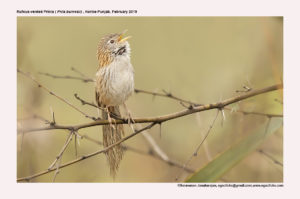Rufous-vented Prinia

Rufous-Vented Prinia Prinia burnesii
Etymology :
- Prinia :Javanese name Prinya for Prinia
- Burnseii: named after British officer Sir AlexanderBurnes (1805–1841)
Distribution in India: Resident of North India ( Best place to see is Harike in Punjab).
Description: Size of 17 cm; wt. of 19 g. It is a large Prinia with very long and strongly graduated tail, outermost rectrices only one third length of central pair. The Male has dark brown streaking overhead, but whitish of chin and throat extends over loral area and about eye, giving striking pale-faced appearance which contrasts with warm buff nape and neck sides. The upperparts are greyish-brown to warm brown, boldly streaked blackish-brown on mantle and scapulars unstreaked with rump and uppertail-coverts. The upperwing-coverts are dark brown with warmer brown feather edges, contrasting with plain grey-brown primaries and secondaries. The tail is olive-brown to grey-brown with weak darker barring. The outermost three or four pairs of tail feathers are with rusty-buff tips and edges. The chin, throat and central underparts are whitish, becoming washed warm buff on flanks, which are finely and inconspicuously streaked dark brown. The undertail-coverts are bright cinnamon-rufous, paler feather tips in very fresh plumage; underwing-coverts are whitish. The plumage becomes greyer and whiter with wear, but rufous vent always evident. The iris is medium brown to dark brown; bill is dark horn with paler tip and lower mandible. The legs are pale flesh-coloured or flesh-brown. The female is similar to male, but has relatively shorter tail, weaker bill, and a light buff wash across breast. The juvenile has feathers softer and more fluffy than those of adults, much lighter streaking than adult, lacks buff collar and is paler rufous on vent; also much fresher tail structure, with darker rufous feather tips shading into brown of remainder of feather It is found in low-lying grassy riverine plains with scattered trees and shrubs, especially acacia and tamarisk, stands of Saccharum grass, with or without Typha and Phragmites.
Food habits: It eats insects. It keeps well hidden, feeding on or near ground in pairs or family parties. It spends most of time low in grassy tussocks, flitting between clumps; generally inconspicuous. It Slips through bases of grassy tussocks with great agility; sometimes feeds on ground, by turning over dead leaves. If flushed, flies low, soon tumbling back into cover.
Breeding habits: They breed in Feb–Sept, chiefly during wet season. The nest is built by female alone. The nest is a deep cup of coarse grasses, lined with vegetable down, fine grasses and few feathers, well concealed at base of grass clump, virtually on ground and often at edge of clearing. They lay a clutch of 4 eggs.